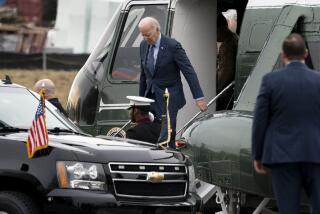Reagan Doctor Says 25th Amendment Should Have Been Used in ’81
- Share via
WASHINGTON — Ronald Reagan’s White House physician said Monday he now believes that executive power should have been transferred to then-Vice President George Bush after Reagan was shot on March 30, 1981.
Dr. Daniel Ruge said that in hindsight, the emergency provisions of the 25th Amendment allowing for the transfer of authority should have been invoked after the assassination attempt.
The doctor, now living in retirement in Denver, said: “I knew all about” the 25th Amendment, “but it never occurred to me” to suggest to Reagan’s aides that it be invoked.
As White House physician, he kept a copy of the 25th Amendment in his bag, Ruge said in a telephone interview from his home.
But in the hours after Reagan was shot in the chest by John W. Hinckley Jr. outside a Washington hotel, Ruge said he was preoccupied with the President’s condition.
Concerned With Patient
“Any physician should be more interested in his patient,” Ruge said. “I have no apologies to make.”
At the time of the shooting, Bush was traveling in Texas. He returned to Washington immediately.
But testimony to a University of Virginia study commission, and statements by officials who were present at the time, confirmed that a general state of confusion existed at the White House after Reagan’s shooting.
There was no clear attempt to address the question of transferring power during the time that Reagan was undergoing emergency surgery to remove a bullet from a lung, or in the several days after when he was in a recovery room at George Washington University Medical Center.
“Somebody should have been looking after the store” during that period, Ruge said, but “fortunately, everything went well. The country moved forward.”
The former White House physician’s remarks were initially reported in Monday’s New York Times.
The White House atmosphere in the hours immediately following Reagan’s shooting was dramatized by the now-famous statement by then-Secretary of State Alexander M. Haig Jr., who proclaimed to reporters: “As of now, I am in control here, in the White House, pending the return of the vice president.”
Section 3 of the 25th Amendment, ratified in 1967, four years after President John F. Kennedy’s assassination, provides for a temporary transfer of executive power to the vice president.
The power remains with the vice president until the President sends a letter to leaders of Congress certifying that he is ready to resume authority.
Fred Fielding, who was Reagan’s chief White House counsel at the time, could not be reached for comment Monday.
Fielding, however, told the University of Virginia study commission that, “to be very frank with you, that day, when I mentioned the 25th Amendment, I could see eyes glazing over in some parts of the Cabinet. They didn’t even know about the 25th Amendment.”
Reagan signed a letter to Capitol Hill leaders in 1985, at the time of his colon cancer surgery, saying he was relinquishing power to Bush during the time he was under general anesthesia.
But White House officials did not actually invoke Section 3 of the 25th Amendment on that occasion.
In a New York Times interview shortly before his inauguration, Bush said that “it never occurred to me” to discuss the 25th Amendment with his campaign running mate, Dan Quayle, now the vice president.
Deputy White House Press Secretary Steven Hart said Monday that a book, “Contingency Plan for Transfer of Presidential Authority,” was compiled in the Reagan White House and has been “updated” by the Bush Administration.
More to Read
Sign up for Essential California
The most important California stories and recommendations in your inbox every morning.
You may occasionally receive promotional content from the Los Angeles Times.













